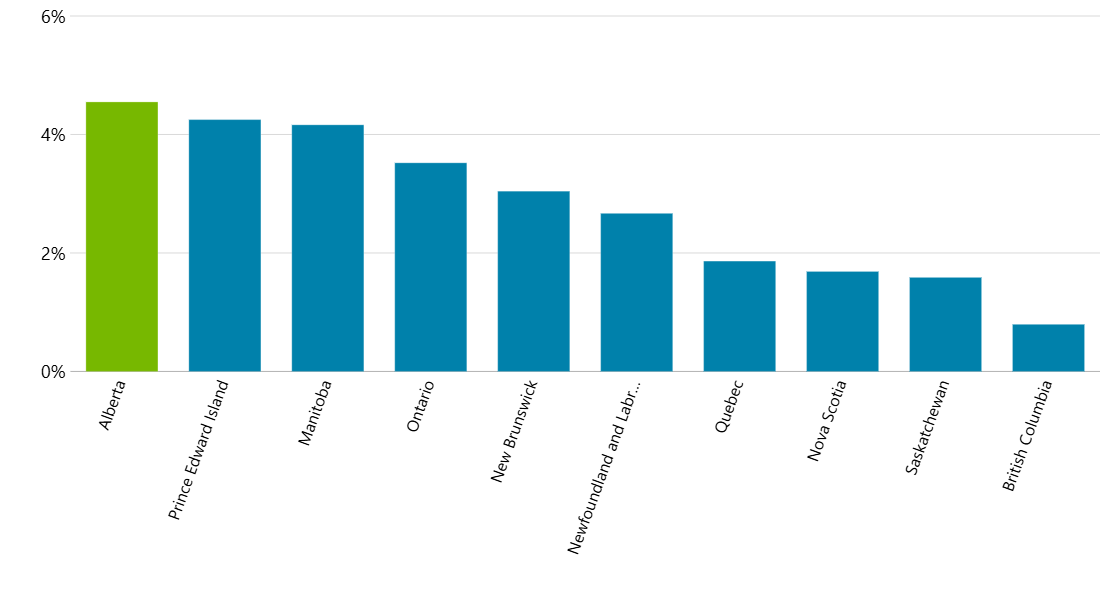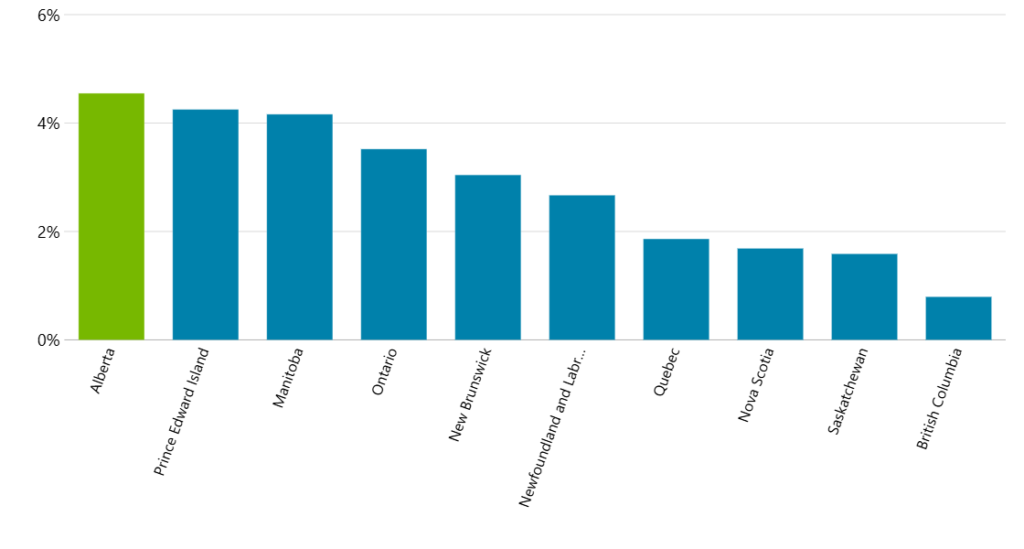Alberta employment statistics open a window to this Canadian province’s dynamic economy. In the past, Alberta relied too much on its huge oil and gas sector. Now, the province tries to balance this traditional sector with emerging ones like technology and healthcare. Despite its push for innovation, Alberta faces challenges like skill gaps and aging workforce. Yet these challenges also present opportunities for job seekers.
Alberta’s Employment Landscape: A Statistical Overview
Alberta Economic Dashboard report shows that Alberta’s employment rate was 64.1% in November 2024. This rate is higher than Canada’s national rate of 60.6%, and it is the highest among all provinces.
 Alberta’s labour market is flourishing, with a 4.5% increase in employment rate from November 2023 to November 2024—the biggest jump among Canadian provinces.
Alberta’s labour market is flourishing, with a 4.5% increase in employment rate from November 2023 to November 2024—the biggest jump among Canadian provinces.
The same report shows that among Alberta’s sub-regions, Wood Buffalo had the highest employment rate at 67.8% in November 2024.
According to Statistics Canada, Alberta’s labour force was about 2.8 million strong in November 2024. The healthcare and social assistance sector is the highest employer, with about 345,400 people. The most notable year-over-year growth is in unclassified industries (43.1%), real estate, rental and leasing (17.6%) and manufacturing (12.7%), reflecting Alberta’s evolving economic landscape.
In November 2024, Alberta’s unemployment rate was 7.5%, according to Statistics Canada data. This is slightly above the national rate of 6.8%. This gap reflects the ongoing challenges, but the focus upon emerging industries and workforce development signals promising opportunities for job seekers.
So, what sectors are driving this optimism? From energy to healthcare and manufacturing, Alberta’s top industries in 2024 hold the answers.
What are Top Industries Driving Alberta’s Job Market in 2024?
Alberta’s economy has long relied on its rich oil and gas resources. However, due to volatility in this sector, Alberta has been working on diversifying its economy. Here’s a look at the top industries in 2024 and their impact on the job market.
Energy Sector: Alberta’s Economic Lifeline
The energy sector will remain the backbone of Alberta’s economy in 2025 and beyond. Alberta’s oil and gas employment stats show that it directly employs about 150,000 people and supports tens of thousands more in industries like manufacturing and transportation.
Alberta’s proven oil sands reserves of 158.9 billion barrels (bb), the fourth largest in the world, make up the bulk of Canada’s national reserves (170.9 bb). This cements Alberta as a global energy hub. (Source: Alberta Energy Regulator)
Additionally, Alberta has about 31 trillion cubic feet of conventional natural gas reserves, more than half of Canada’s total and the largest in North America. (Source:Ressources naturelles Canada)
Alberta’s Immense resource wealth continues to anchor its economy and shape the job market. Companies like Suncor Energy Inc. (Alberta-based) and Canadian Natural Gas Limited (CNGL), which drive oil-and-gas extraction and production operations in Alberta, employ tens of thousands of Albertans and generate billions of dollars in revenue.
Moreover, Alberta’s oil and gas sector significantly influences other industries like manufacturing and transportation. The manufacturing industry, employing over 127,400 people, transforms raw petroleum into essential products such as petrol, lubricants, plastics, and synthetic materials etc. The transportation sector also depends on oil and gas to move raw materials and finished products across sources, storage facilities, pipelines and production hubs.
However, Alberta’s heavy reliance on oil and gas has made it somewhat vulnerable to economic volatility during downturns. To counter this, both public and private sectors have moved towards diversification. Initiatives like Alberta’s Industrial Heartland Association are fostering investments in petrochemical industries, enabling sectors like plastics, chemicals and fertilizer to flourish. This approach not only adds value to existing resources but also creates new and more stable job opportunities.
Similarly, the renewable energy sector is emerging as a promising alternative to fossil fuels. Alberta is seeing substantial investment in wind and solar energy generation.

It is encouraging to know that 26% of Alberta’s energy in 2023 came from renewables like wind and solar. This figure is expected to exceed 30% by 2026, according to AESO (Alberta Electric System Operator).
Alberta has seen 14 recent and upcoming mega wind projects launched or announced. The province currently accounts for 37% of Canada’s installed wind energy capacity. (source: Renewable Energy Canada)
On the solar front, the Travers Solar Project, with its 1.3 million solar panels, adds 465 MW of clean energy to Alberta’s electricity grid. With 44 operational solar farms and several more underway, Alberta’s renewable energy horizon looks bright. This Green drive creates many new job opportunities in project management, maintenance and green technology innovation.
According to Yale Environment 360, about 8200 people work as solar installers and 3200 as wind turbine technicians in Alberta—a workforce poised for significant growth. With increasing investments in renewables, Alberta is truly experiencing the “winds of change.”
Healthcare and Social Assistance Sector: Alberta’s Largest Employer
Amid debates about Alberta’s oil and gas and green-energy sectors, Healthcare and Social Assistance has emerged as the province’s largest employer. According to Statistics Canada, this sector employs 345,400 people in Alberta in various roles. Its dominance is due to Alberta’s growing population and aging demographics. Alberta Health Services (AHS) is a key player, with about 128,000 staff, including nurses, physicians, healthcare aides (HCAs), lab technicians, mental health professionals and social workers.
Alberta’s aging population is driving the demand for healthcare services. Currently, 16% of Albertans are 65 years and older, a figure expected to rise to 20% soon. The average age of Albertans was 39 years in 2022 and is projected to reach 41.6 years by mid-century. (Sources: Government of Alberta & Open Government Program)
The aging population, combined with significant investments like $1.4 billion allocated for the Calgary Cancer Center (reported by Strathmore Now), has increased the need for healthcare professionals in Alberta.
The rise of telemedicine—propelled by the COVID-19 pandemic—has added a new dimension to healthcare. Since 2020, Alberta’s virtual care sub-sector has grown by 25% and is expected to grow at a rate (CAGR) of 19.6% through 2030. Source: Canadian Medical Association (CMA).
Despite this robust growth, Alberta’s healthcare sector faces critical challenges like worker shortages and skill gaps. The Government of Alberta’s Occupational Outlook report (published 2023) forecasts a shortage of over 4000 workers in roles such as registered nurses, nurse aides, licensed practical nurses, and paramedics. To address this, the government has launched recruitment drives, international hiring initiatives and enhanced training programs to equip nurses and healthcare aides. For those pursuing careers in healthcare, Alberta offers stability and Immense opportunities.
Manufacturing Sector: Adding Value to Alberta’s Resources
Alberta’s manufacturing sector employs about 163,300 individuals, according to November 2024 data by Alberta Economic Dashboard. This is a robust 10% increase from the previous year, showcasing the sector’s resilience and growth potential.
The industry spans 21 diverse subsectors, with food production, wood products, fertilizers, chemicals, and advanced fields like computer and electronic manufacturing. This range highlights the sector’s dual role in both resource-driven and value-added production.
A significant portion of Alberta’s manufacturing operates as downstream industries, adding value by refining and processing core Alberta’s oil and gas reserves into high-value products like plastics, petrochemicals and synthetic materials. Major players like NOVA Chemicals and Dow Canada lead the sector, driving innovation and employment.
Alberta’s food manufacturing sub-sector accounts for nearly 16% of manufacturing and employment activity, focusing on meat processing, grains and dairy products. Similarly, the chemical and machinery manufacturing sub-sectors collectively employ 22% of the sector’s workforce. Wood and fabricated metal products manufacturing account for roughly 23.4% of employment activity. (Source: Job Bank Canada)
According to Job Bank Canada, 20% of manufacturing sector employees in Alberta are aged 55 years or older, amounting to approximately 33000 workers nearing retirement. This imminent wave of retirements will create significant job vacancies, promising new opportunities for entrants to the industry.
Technology and Innovation: Alberta’s Emerging Frontier
According to a Calgary Tech report, Alberta had about 108,000 tech workers at the end of 2023, with an expected increase to 110,000 by the end of 2024.
Alberta is building on its robust oil and gas economy to rapidly modernize technology. Key urban hubs like Edmonton and Calgary are leading this transformation by fostering tech ecosystems. Initiatives like Platform Calgary and Edmonton’s Artificial Intelligence Hub have become innovation centers, creating new job opportunities in AI, automation, software development, nanotechnology, quantum computing and robotics. These innovations have made Alberta a hub for technology-driven jobs.
According to Alberta Enterprise Corporation (AEP) and Invest Alberta’s data, Alberta’s tech companies secured investments of $707 million in VC funds and $840 million in PE funds in 2023—a 26% increase from 2021. These investments were spread across 88 deals. The Edmonton region, named as North America’s aspiring technology hub, received 21 of these deals, worth $188 million.
“Edmonton Region was ranked as North America’s fastest-growing tech ecosystem – and we’re just getting started.” Malcolm Bruce, the CEO of Edmonton Global, proudly stated.
The Alberta government is driving tech growth by investing directly in tech ventures or launching initiatives to attract more investments. On December 4, 2024, the province launched its AI Data Center Strategy, aiming to secure $100 billion in private investments over the next five years. This initiative addresses the soaring global demand for data centers, which are expected to triple by 2030, and positions Alberta as a leader in AI infrastructure across North America. It will also create a sustainable and competitive IT job market future. (Source: MLT Aikins)
Alberta’s thriving tech sector is poised to anchor its diversified economy, with technological advancements permeating all industries. The demand for skilled roles such as software developers, data analysts, and AI engineers continues to grow rapidly across the province’s employment landscape.
Agriculture and Agri-Food: Alberta’s Steady Pillar
According to the latest data from Statistics Canada, Alberta’s agriculture workforce is 38,358 as of 2024. This figure underscores the agriculture sector’s importance as a major employer.
Alberta is the third-largest agricultural exporter in Canada, following Ontario and Saskatchewan. In 2023, Alberta’s Agri-Food exports reached a record $17.7 billion. This is roughly 10% of the province’s total international merchandise exports that year. (Source: ATB)
Alberta’s main agricultural products include wheat, canola, beef and pork, with major export destinations being the United States, China and Japan. (Source: Policy School report)
Despite its strengths, Alberta’s agriculture sector faces a critical skilled labor shortage. A report by the Canada Agricultural Human Resource Council suggests that 50% of agricultural employers in Alberta couldn’t fill all their positions. This led to cancelled expansions and lost sales. Additionally, 40% of the current labor force in the Agri sector is expected to retire before 2030. This will create a big vacuum if the positions are not promptly filled.
To address these challenges, Alberta is investing in sustainable farming practices and modern production methods to boost output and meet global demand. With nearly half of the agricultural workforce expected to retire soon, there are abundant opportunities in farm operations, food processing, business management and Agri-Tech. Job seekers with requisite skills and experience can secure long-term roles in this sector.
Construction and Infrastructure Sector: Building Alberta’s Future
The construction and infrastructure sector is a major player in Alberta. The latest data from Alberta’s Open Government Program suggests that this sector employs 241,500 individuals, highlighting its significant size.
According to the Construction Labor Relations Alberta (CLRA), the construction sector added 12,767 more jobs in January 2024 compared to January 2023. This positions the sector as the fastest-growing job creator.
This sector is driven by substantial investment in infrastructure projects. In 2024, the Albertan government invested $818 million in over 200 infrastructure repair and building projects, enhancing connectivity and creating thousands of jobs. (Source: Justin Wright, Albertan politician and businessman, Facebook)
Other projects include the Edmonton-Calgary High-Speed Rail, valued at $9 billion, and Calgary’s Green Line LRT, a $5.5 billion initiative starting in 2024. (Source: ICBA Independent)
Looking ahead, the construction industry is expected to continue growing. Projections indicate a 14% increase in non-residential employment over the next decade. (Source: GlobeNewsWire)
For job seekers, this sector offers a range of opportunities, from skilled roles to project management positions.
Real Estate and Rental Services: Growing with Population
According to Alberta Worker data, the Real estate and rental sector is one of Alberta’s top 10 highest employing industries (6.1%). As of 2024, this sector’s total employment stands at about 25000 and its contribution to the province’s GDP is $41.58 billion. (Source: IBIS World)
Population surge has intensified demand for housing and rentals in Alberta. Alberta’s population grew by 204,677 people in 2023-2024, marking a 4.41% growth rate—the highest among all Canadian provinces. This record growth is largely due to interprovincial and international immigration. In the first quarter of 2024, some 32,893 new international migrants were added. (Source: CIC News)
In Calgary, Q2 of 2024 saw the sale of 8,704 housing units, which is 38.7% more than the same period last year. Consequently, benchmark prices are rising sharply (over 6%). (City of Calgary)
Edmonton’s rental market is also tightening. Vacancy rates were just 1.4% in 2023 and are further expected to decrease to 1.1% in 2024. (source: Calgary)
These problems of increasing demands and decreasing vacancy rates need solutions. Developers are now focusing on multi-family housing projects. The Alberta government allocated $93 million in 2023 for the Affordable Housing Partnership Program. (Source: Alberta)
Growth in the real estate and rental sector is creating job opportunities in property management, real estate sales, construction and urban planning. Real estate agents and salespersons in Alberta have strong job prospects for 2024-2026.
Employment Trends: Opportunities and Challenges Ahead
Alberta’s job market is growing fast. It presents both opportunities and challenges for workers and employers alike. Emerging industries like technology and renewable energy look promising, but key challenges like skill shortages and workforce adaptability remain pressing concerns.
Skill Shortages and Retirements
According to the Government of Alberta’s Occupational Outlook Report 2024, many sectors are struggling to fill critical roles. Healthcare, construction and manufacturing alone are expecting to face 25,000 job vacancies by 2026 due to worker retirements and expansion plans. Similarly, nearly 40% of the agricultural workforce will retire by 2030.
Technology Transforming Roles
Automation and AI are reshaping traditional jobs. The World Economic Forum predicts 50% of all employees will need Reskilling to adapt. Alberta is no exception, with high demand for workers skilled in AI, robotics and data analysis.
Upskilling Opportunities
For employers and job seekers, government and private institutions are offering solutions. Programs like Canada-Alberta Job Grant offer financial support to train workers for high-demand roles. Alberta’s universities and technical colleges are also partnering with industries to offer specialized certifications in different areas like advanced manufacturing, health tech and renewable energy.
Key Takeaways for Job Seekers
The future of Alberta’s workforce lies in adaptability and continuous learning. Staying updated with market trends and acquiring relevant certifications can give job seekers a competitive edge.
Conclusion: Alberta’s Changing Employment Landscape
Alberta’s employment landscape in 2024 is at the crossroads of tradition and innovation. While sectors like oil-and-gas continue to employ over 140,000 workers, according to the Job Bank’s Alberta Sector Profile, emerging industries like technology sector, AI, renewable energy and virtual care are reshaping the job market. Alberta’s tech workforce, for example, grew by 26% since 2021, with projections to hit 110,000 jobs by the end of 2024. (Calgary Tech, 2023)
Yet challenges persist. Aging workforce, particularly in manufacturing and agricultural sectors, creates an urgent need for skilled replacements. For instance, agricultural employment reduced by 44% from 2013 to 2022, according to the Job Bank’s Sector Profile. Similarly, 20% of manufacturing workers are nearing retirement. Meanwhile, the healthcare and education sectors face worsening staff shortages due to increased demand. (Job Bank’s Sectoral Profile)
For job-seekers, the message is clear and simple: adaptability and upskilling are key to securing positions in Alberta. They can stay ahead of the curve through certifications, apprenticeships, or career coaching. For businesses, it’s a ripe time to invest in innovation, workforce development and upskilling.
But apart from skills, job seekers need strategies. With industries like healthcare, tech and energy offering opportunities, a well-crafted resume and strategic career guidance can make all the difference. Investing in professional career coaching and resume writing services can help job seekers to align their skills with market demands.
Frequently Asked Questions
Q. What is the employment rate in Alberta in 2024?
As of November 2024, the employment rate in Alberta is 64.1%. This figure is higher than Canada’s national employment rate of about 60.6%.
Q. What are Alberta’s top industries with the highest vacancy rates in 2024?
Alberta’s top hiring industries in 2024 include Accommodation and Food Services, making up 7% of job vacancies (11,765), followed by Construction at 5.3% (10,460) and Retail Trade at 4% (8,960). Other key sectors include Healthcare and Social Assistance (3%, 7,610) and Transportation and Warehousing. For more details, visit the Government of Alberta website page.
Q. How can job seekers prepare for Alberta’s employment market?
Job seekers should focus on adaptability and skill development. Getting certifications in their relevant field can increase their prospects. Career coaching and resume writing services, like those offered by Mokid, help align skills with employment needs. (Government of Alberta training program.)
Q. Which regions in Alberta offer the most job opportunities in the tech sector?
Edmonton and Calgary are Alberta’s leading tech hubs. Edmonton boasts over 45,000 tech workers and 1,700+ tech companies, according to Edmonton Global. Meanwhile, Calgary—the city with the fastest-growing tech sector—hosts a 60,000-strong tech workforce, as noted by Platform Calgary.
Q. Which region in Alberta has the highest employment rate?
As of November 2024, Alberta’s Wood Buffalo-Cold Lake sub-region showed the highest rate of employment, which is about 67.8%.
Q. Which region in Alberta has the highest employment?
November 2024 data by Job Bank Canada suggests that Alberta’s metropolitan Calgary boasts the highest employment, which is 997,800. Edmonton closely follows this with 892,000 employed people. Red Deer comes in third with a 120,700 workforce strength.





